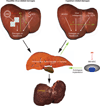Androgen receptor roles in hepatocellular carcinoma, fatty liver, cirrhosis and hepatitis
- PMID: 24424503
- PMCID: PMC4165608
- DOI: 10.1530/ERC-13-0283
Androgen receptor roles in hepatocellular carcinoma, fatty liver, cirrhosis and hepatitis
Abstract
Androgen/androgen receptor (AR) signaling plays important roles in normal liver function and in progression of liver diseases. In studies of noncancerous liver diseases, AR knockout mouse models of liver disease have revealed that androgen/AR signaling suppresses the development of steatosis, virus-related hepatitis, and cirrhosis. In addition, studies have shown that targeting AR in bone marrow-derived mesenchymal stem cells (BM-MSCs) improves their self-renewal and migration potentials, thereby increasing the efficacy of BM-MSC transplantation as a way to control the progression of cirrhosis. Androgen/AR signaling is known to be involved in the initiation of carcinogen- or hepatitis B virus-related hepatocellular carcinoma (HCC). However, studies have demonstrated that AR, rather than androgen, plays the dominant role in cancer initiation. Therefore, targeting AR might be an appropriate therapy for patients with early-stage HCC. In contrast, androgen/AR signaling has been shown to suppress metastasis of HCC in patients with late-stage disease. In addition, there is evidence that therapy comprising Sorafenib and agents that enhance the functional expression of AR may suppress the progression of late-stage HCC.
Keywords: androgen receptor (AR); hepatocellular carcinoma (HCC).
Conflict of interest statement
Conflict of interest: ASC-J9® was patented by the University of Rochester, the University of North Carolina, and AndroScience, and then licensed to AndroScience. Both the University of Rochester and C.C. own royalties and equity in AndroScience.
Figures



Similar articles
-
Hepatic androgen receptor suppresses hepatocellular carcinoma metastasis through modulation of cell migration and anoikis.Hepatology. 2012 Jul;56(1):176-85. doi: 10.1002/hep.25644. Epub 2012 Jun 5. Hepatology. 2012. PMID: 22318717 Free PMC article.
-
Androgen receptor (AR)/miR-520f-3p/SOX9 signaling is involved in altering hepatocellular carcinoma (HCC) cell sensitivity to the Sorafenib therapy under hypoxia via increasing cancer stem cells phenotype.Cancer Lett. 2019 Mar 1;444:175-187. doi: 10.1016/j.canlet.2018.11.004. Epub 2018 Nov 15. Cancer Lett. 2019. PMID: 30448543
-
Androgen receptor mitigates postoperative disease progression of hepatocellular carcinoma by suppressing CD90+ populations and cell migration and by promoting anoikis in circulating tumor cells.Oncotarget. 2016 Jul 19;7(29):46448-46465. doi: 10.18632/oncotarget.10186. Oncotarget. 2016. PMID: 27340775 Free PMC article.
-
Androgen receptor signaling in hepatocellular carcinoma and pancreatic cancers.World J Gastroenterol. 2014 Jul 28;20(28):9229-36. doi: 10.3748/wjg.v20.i28.9229. World J Gastroenterol. 2014. PMID: 25071315 Free PMC article. Review.
-
Hierarchical and selective roles of galectins in hepatocarcinogenesis, liver fibrosis and inflammation of hepatocellular carcinoma.World J Gastroenterol. 2013 Dec 21;19(47):8831-49. doi: 10.3748/wjg.v19.i47.8831. World J Gastroenterol. 2013. PMID: 24379606 Free PMC article. Review.
Cited by
-
Androgen/androgen receptor axis maintains and promotes cancer cell stemness through direct activation of Nanog transcription in hepatocellular carcinoma.Oncotarget. 2016 Jun 14;7(24):36814-36828. doi: 10.18632/oncotarget.9192. Oncotarget. 2016. PMID: 27167111 Free PMC article.
-
DNAJC24 is a potential therapeutic target in hepatocellular carcinoma through affecting ammonia metabolism.Cell Death Dis. 2022 May 24;13(5):490. doi: 10.1038/s41419-022-04953-z. Cell Death Dis. 2022. PMID: 35606363 Free PMC article.
-
The clinicopathological and prognostic factors of hepatocellular carcinoma: a 10-year tertiary center experience in Egypt.World J Surg Oncol. 2022 Sep 19;20(1):298. doi: 10.1186/s12957-022-02764-2. World J Surg Oncol. 2022. PMID: 36117166 Free PMC article.
-
The miR-92a-2-5p in exosomes from macrophages increases liver cancer cells invasion via altering the AR/PHLPP/p-AKT/β-catenin signaling.Cell Death Differ. 2020 Dec;27(12):3258-3272. doi: 10.1038/s41418-020-0575-3. Epub 2020 Jun 25. Cell Death Differ. 2020. PMID: 32587378 Free PMC article.
-
ABL1, Overexpressed in Hepatocellular Carcinomas, Regulates Expression of NOTCH1 and Promotes Development of Liver Tumors in Mice.Gastroenterology. 2020 Jul;159(1):289-305.e16. doi: 10.1053/j.gastro.2020.03.013. Epub 2020 Jun 24. Gastroenterology. 2020. PMID: 32171747 Free PMC article.
References
-
- Aspinall EJ, Hawkins G, Fraser A, Hutchinson SJ, Goldberg D. Hepatitis B prevention, diagnosis, treatment and care: a review. Occup Med (Lond) 2011;61:531–540. - PubMed
-
- Baig S. Gender disparity in infections of Hepatitis B virus. J Coll Physicians Surg Pak. 2009;19:598–600. - PubMed
-
- Bradbury MW. Lipid metabolism and liver inflammationIHepatic fatty acid uptake: possible role in steatosis. Am J Physiol Gastrointest Liver Physiol. 2006;290:G194–G198. - PubMed
Publication types
MeSH terms
Substances
Grants and funding
LinkOut - more resources
Full Text Sources
Other Literature Sources
Medical
Research Materials

